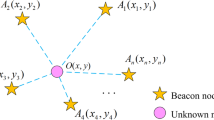Abstract
Traditional particle swarm optimization (PSO) localization method can achieve good localization accuracy with the advantages of fewer parameters and simpler calculations. However, its localization performance is constrained by the limited ranging information available between the anchor node and the unknown node. Thus, an improved PSO localization method is proposed to further improve the localization performance. Firstly, we use the ranging information between the unknown node and the anchor node to make an initial positioning through the traditional PSO method. Then, based on the initial positioning, all ranging information is employed to calculate a more precise location. Compared with the traditional PSO method, the proposed algorithm can reduce the impact of the ranging error and improve localization performance.











Similar content being viewed by others
References
Drutarovsky, M., Kocur, D., & Svecova, M. (2017). Real-time wireless UWB sensor network for person monitoring. In 14th international conference on telecommunications (pp. 19–26). IEEE.
Schmidt, J. F., Chernov, D., Pauritsch, M. & Bettstetter, C. (2019). Study of a self-powered UWB sensor network for industrial applications. In European wireless conference (pp. 77–82). IEEE.
Sharma, S., Gupta, A., & Bhatia, V. (2018). IR-UWB sensor network using massive MIMO decision fusion: Design and performance analysis. IEEE Sensors Journal, 18(15), 6290–6302.
Tsuchiyama, K., & Kajiwara, A. (2019). Accident detection and health-monitoring UWB Sensor in toilet. In IEEE topical conference on wireless sensors and sensor networks (pp. 1–4). IEEE.
Eryildirim, A., & Guldogan, M. B. (2016). A bernoulli filter for extended target tracking using random matrices in a UWB sensor network. IEEE Sensors Journal, 16(11), 4362–4373.
Xu, X., Liu, X., Zhao, B. & Yang, Bo. (2019). An extensible positioning system for locating mobile robots in unfamiliar environments. Sensors (Basel, Switzerland),19(18),1–21.
Luomala, J., & Hakala, I. (2019). Analysis and evaluation of adaptive RSSI-based ranging in outdoor wireless sensor networks. Ad Hoc Networks, 87, 100–112.
Xue, W. X., Qiu, W. N., Hua, X. H. & Yu, K. G. (2017). Improved Wi-Fi RSSI measurement for indoor localization. IEEE Sensors Journal, 17(7), 2224–2230.
Yang, Z., Zhu, S., Chen, C., Guan, X. & Feng, G. (2019). Distributed path optimisation of mobile sensor networks for AOA target localisation. In IET control theory and applications (vol. 13, no. 17, pp. 2817–2827). IEEE.
Ji, Y., Song, J., Sun, X., Yan, S. & Yang Z. (2018). TOA estimation algorithm based on noncoherent detection in IR-UWB system. International Conference on Wireless Algorithms, Systems, and Applications, 10874, 201–210.
Xie, Y., Janssen, G. J. M., Shakeri, S. & Tiberius C. C. J. M. (2017) UWB pulse detection and TOA estimation using GLRT. Eurasip Journal on Advances in Signal Processing, 13, 1–12.
Ren, Q., Zhang, Y., & Nikolaidis, I. (2020) RSSI quantization and genetic algorithm based localization in wireless sensor networks. Ad Hoc Networks, 17(1), 1–8.
Lu, J., & Yang, X. (2019). Taylor series localization algorithm based on semi-definite programming. In IEEE artificial intelligence and security—5th international conference (pp. 488–497). IEEE.
Hijazi, H., Kandil, N., Zaarour, N. & Hakem N. (2019). Gradient descent localization algorithm based on received signal strength technique in a noisy wireless sensor network. In 4th International conference on advances in computational tools for engineering applications (pp. 1–5). IEEE.
Wu, H., & Liu, J. (2020). A hybrid mobile node localization algorithm based on adaptive MCB-PSO approach in wireless sensor networks. In Wireless communications and mobile computing (pp. 1–7).
Zhang, X., Wang, T., & Fang, J. (2014). A node localization approach using particle swarm optimization in wireless sensor networks. In International conference on identification, information and knowledge in the internet of things (pp. 84–87). IEEE.
Monica, S., & Ferrari, S. G. (2014). Accurate indoor localization with UWB wireless sensor networks. In the 23rd IEEE international WETICE conference (pp. 287–289). IEEE.
Su, X., & Lei, Z. S. (2011). Improved centroid algorithm localization for WSN based on particle swarm optimization. In the 4th international symposium on computational intelligence and design (pp.139–142). IEEE.
Yang, Y., Li, B., & Ye, B. (2016). Wireless sensor network localization based on PSO algorithm in NLOS environment. In the 8th international conference on intelligent human–machine systems and cybernetics (pp. 292–295). IEEE.
Lv, J. L., Wang, Y. L., & Cui, H. Q. (2013). Weight selection and PSO based three-dimensional localization for wireless sensor networks. Applied Mechanics and Materials, 2540–2544.
Chen, X., & Zou, S. (2017). Improved Wi-Fi indoor positioning based on particle swarm optimization. IEEE Sensors Journal, 17(21), 7143–7148.
Shen, S., Sun, L., & Dang, Y. (2018). Node localization based on improved PSO and mobile nodes for environmental monitoring WSNs. International Journal of Wireless Information Networks, 25, 470–479.
Hao, Z., Li, X., & Ding, Y. (2018). An improved PSO algorithm for node localization in indoor long-narrow confined space. In IEEE conference on industrial electronics and applications (pp. 1841–184). IEEE.
Nagireddy, V., Parwekar, P., & Mishra, T. K. (2018). Velocity adaptation based PSO for localization in wireless sensor networks. Evolutionary Intelligence, 1–9.
Batra, A., Balakrishnan, J., & Aiello, G. R. (2004). Design of a multiband OFDM system for realistic UWB channel environments. IEEE Transactions Microwave Theory Techniques, 52(91), 2123–2138.
Acknowledgements
This work was supported in part by the National Natural Science Foundation of China under Grant 61701286, in part by Shandong Provincial Natural Science Foundation, China (ZR2017MF047, ZR2019MF024).
Author information
Authors and Affiliations
Corresponding author
Additional information
Publisher's Note
Springer Nature remains neutral with regard to jurisdictional claims in published maps and institutional affiliations.
Rights and permissions
About this article
Cite this article
Xia, B., Liu, T., Ding, T. et al. An Improved PSO Localization Algorithm for UWB Sensor Networks. Wireless Pers Commun 117, 2207–2223 (2021). https://doi.org/10.1007/s11277-020-07968-x
Accepted:
Published:
Issue Date:
DOI: https://doi.org/10.1007/s11277-020-07968-x




